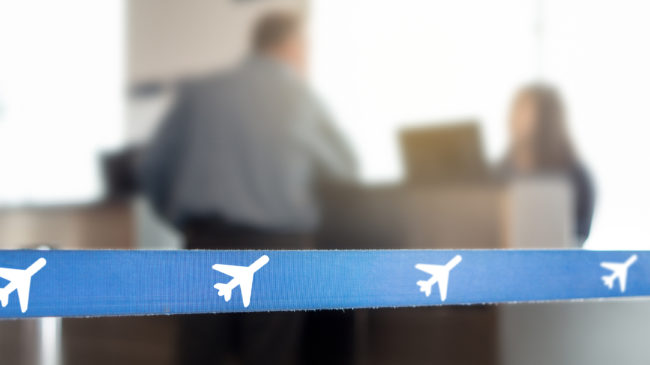After weeks of maintaining their neutrality, last week many airlines decided to support airline union calls for another large federal subsidy to maintain existing airline workforces. The $2.2 trillion Coronavirus Aid, Relief, and Economic Security Act (CARES Act) signed by President Donald Trump included $32 billion in aid for airlines to prevent the involuntary termination of airline employees until Oct. 1. As that date grows nearer, the airline unions have stepped up their calls another $32 billion airline bailout, in order to extend the airlines’ employment freeze for six additional months.
Yesterday, President Trump said he supports giving more taxpayer-funded aid to airlines. Marketplace reports:
President Donald Trump said Wednesday he would support additional aid for airlines to keep workers on payroll. The president was asked about a plan from more than a dozen Republican senators to provide another $25 billion in support for airlines.
“I think it’s very important that we keep the airlines going,” he said. “We don’t want to lose our airlines.”
Arguments from Trump and the airline unions include the concern that airlines could lose many thousands of skilled professionals they will need as the demand for air travel returns and grows in the future. There are also very real human concerns for mid-career people losing good-paying jobs that may be hard for them to replace. I can understand these human concerns. I grew up in an airline family, and we had hard times during several long strikes, one of which shut the entire airline down and left my dad temporarily out of work. Some years later, my best friend’s father—a flight engineer—lost his job when new cockpit technology eliminated the need for such a position.
But those human concerns collide with a harsh reality: air travel will not have recovered six months from now, and the post-pandemic aviation industry will be quite different from what it was in recent decades.
The International Air Transport Association (IATA) recently revised its forecast of when air travel may return to pre-coronavirus pandemic 2019 levels. Instead of returning to those levels by 2023, which it had predicted a few months ago, IATA now thinks it will take until 2024 for the industry to get back to 2019 levels.
Yet, U.S. airlines and their unions want to keep huge numbers of people on the payroll for another six months—and then what? Presumably, even more federal subsidies.
Paying tens of thousands of airline employees not to work for three more years—waiting for air travel to return to pre-pandemic levels— makes no sense for federal taxpayers or airlines. Based on economic conditions and demand, downsizing needs to happen and there is no point putting it off for six months.
The airlines know this, and have been preparing their legally-required notifications:
- American has said it will soon issue 25,000 furlough notices;
- Delta has thanked more than 17,000 employees who have accepted buyouts and early-retirement packages;
- Southwest has not issued furlough notices, but has encouraged early retirements; and,
- United has outlined plans for up to 61,000 furlough notices.
A possible reason for major airlines to support payroll subsidies is more disturbing. It is basically an attempt to preserve the status-quo structure of the industry, in which the big four carriers provide more than three-fourths of all U.S. air service. But that attempt flies in the face of foreseeable changes in post-pandemic air travel. Thanks to Zoom and similar video conferencing services, business travel is likely to be a smaller fraction of the total, especially international business travel. Business travel is the most lucrative market segment for the legacy carriers, especially the international portion.
As air travel resumes, domestic and leisure travel are likely to be significantly larger fractions of the total. That plays to the strength of smaller airlines such as Alaska, Hawaiian, and Jet Blue, and especially ultra-low-cost carriers Allegiant, Frontier, and Spirit. Expanded market share for these smaller airlines would be good for air travelers since their low fares have been shown to exert downward pressure on the fares charged by the legacy carriers. But this also means relative shrinkage of the big legacy carriers.
Attempts to maintain the status quo in a dynamic industry that needs to change would be central planning of the worst kind. Another round of federal bailouts for airlines would be a triumph of stasis over dynamism, of the kind as Virginia Postrel discussed in her book, The Future and Its Enemies.
We would not even be having this debate, were it not for Congress’ propensity to throw taxpayers’ money at problems—these days on an unprecedented scale.
In its recent lead editorial, The Economist identified this danger, writing:
One of monetarism’s key insights was that sprawling macroeconomic management leads to infinite opportunities for politicians to play favourites. Already they are deciding which firms get tax breaks and which workers should be paid by the state to wait for their old jobs to reappear. Soon some loans to the private sector will turn sour, leaving governments to choose which firms fail. When money is free, why not rescue companies, protect obsolete jobs and save investors?
However, though that would provide a brief stimulus, it is a recipe for distorted markets, moral hazard and low growth.
The airlines and their employees undoubtedly face tough times ahead, but taxpayers should not provide tens of billions in federal bailout funding so the airlines can delay those decisions for six months.

